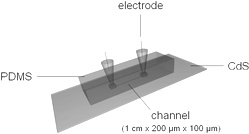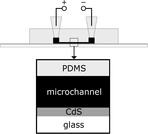|
Principal Investigator: Pál Ormos
Electroosmosis can be effectively used to manipulate fluid in microfluidic systems. The flow can
be controlled by the geometry of the system, the zeta-potential of the channel walls, and the
structure of the electric field itself which drives electroosmosis. In our concept we use light to
dynamically modify the spatial structure of the electric field to control the flow. The conductivity
of a photoconductor film parallel to a microfluidic channel is changed dynamically by appropriate
illumination. A local increase in the conductivity upon excitation results in the reduction of the
electric field in the corresponding microchannel region, and thus the local electroosmotic driving
force. This way it is possible to realize a range of functions needed for the manipulation of fluids like
switching of flow, (re)directing flow and mixing. The concept is demonstrated experimentally, modeled and interpreted.
Reference: L. Oroszi, A. Dér, H. Kirei, V. Rakovics, and P. Ormos, Control of electroosmostic flow by light, Appl. Phys. Lett. 89 263508 (2006) |


